Neurodiversity information for parents and young people
Scar after caesarean
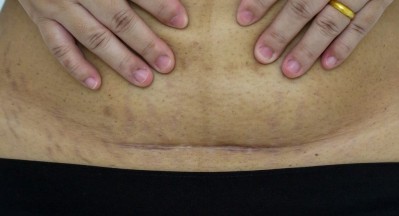
When a scar is formed, fibres are laid down in many directions. These fibres can sometimes stick (‘’adhere’’) to surrounding tissues. For a few people, too much scar tissue (also called “adhesions”) can form and leave the scar feeling tight and sore.
Following a caesarean, too much scar tissue around the operation scar is often described as a pulling and tugging sensation. This can make daily activities and sex uncomfortable and may affect bladder and bowel function. It can also slow the recovery of your tummy (abdominal) muscles and contribute to backache.
Scar massage can help recovery
Once your scar has fully healed, your midwife may suggest you massage it. Scar massage is simple and aims to break up the scar tissue. This can reduce any itching and swelling and improve its appearance.
Not much research has been done to find out how well this massage works, but some people find it helpful.
When to start
If you feel comfortable and ready, you can start massaging your scar once your wound has fully healed. There should be no scabs or openings left. Scars are usually fully healed 6 to 8 weeks after a caesarean birth. If you are unsure, check with your health visitor, midwife or GP before starting any massage.
It is important to get the timing right. Massaging your scar too soon could cause it to reopen or tear, leading to an infection. But it is never too late to start.
How to do the massage
It is normal to feel a pulling or burning sensation when you start massaging your scar. Increase the pressure gradually and spend a couple of minutes on each technique. You may find it easier to massage your scar whilst having a bath, or try after a shower using any oil of your choice (if you are not allergic).
If you get any pain whilst massaging your scar, stop and leave it for a few weeks. Then come back to it. If the pain persists, speak to your GP.
Feeling your scar
Your scar may feel sensitive or tender. Or you may have less sensation or even numbness in some areas.
When you first start the massage, it may help to touch the surrounding skin without touching the scar itself. Try tracing small circles with your fingers, or moving the skin around. Then gently move towards the scar itself. If the skin is particularly sensitive, try all this with a cotton ball at first.
The scar tissue is not limited to the scar. So it is important to work around the scar too.
When you feel comfortable doing so, you can move on to massage the scar.
Massage your scar with the pads of 2 or 3 fingers together
Circle: make circular movements above, below and on the scar itself, if you can tolerate it. Repeat clockwise and anti-clockwise, 5 to 10 times.
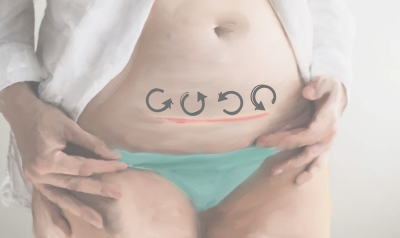
Vertical: Pull across the scar, up and down, with short then longer strokes. Repeat 5 to 10 times.
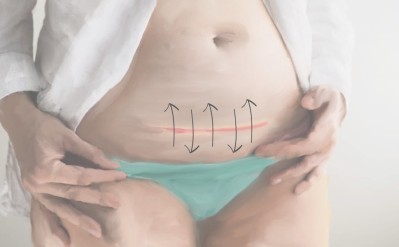
Left and right: rest your hand or fingers on your scar and encourage your scar to move left and right (along the scar) for 10 to 15 secs. Then using your other hand encourage it in the opposite direction.
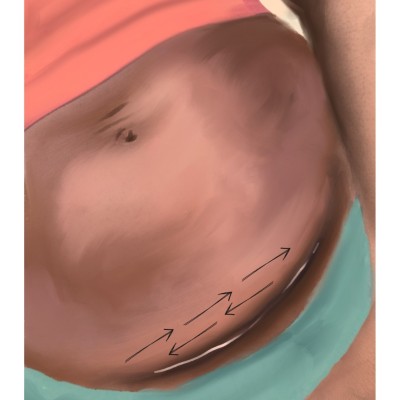
Pinch some tissue around or on the scar then roll the pinched skin up and down and side to side for about 10 to 15 seconds. Move along the entire length of the scar, repeat every 1/2 inch to 1 inch.
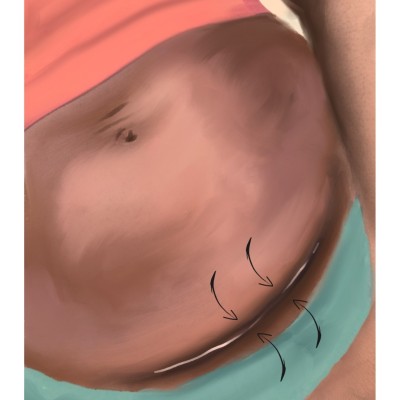
How often
We recommend doing theses stretches at least 4 times a week. At first, do it for 5 to 10 minutes each time. Then, when it feels less uncomfortable and the scar movement increases, you can gradually reduce how often you do it. Scar tissue continues to form for up to 2 years after an injury or surgery so regular massage is a good idea.
When to get advice
Remember to be kind and patient with yourself. Birth recovery is about caring for your body as well as processing your birth experience. If you are having difficulties with this, you can contact a healthcare professional such as your midwife, health visitor or your GP for support.
You can also get in touch with the NHS Talking Therapies programme.
Contact information
Speak to your GP for more advice